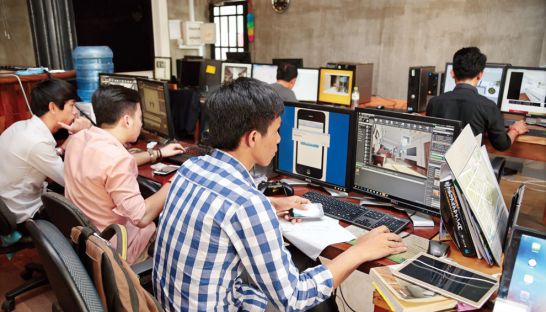Make space for the future of showrooms
Make space for the future of showrooms
Prestigious real estate developers invest millions of dollars in showrooms that are supposed to convince property investors and buyers of the quality of off-plan residential units. Yu Kobayashi, CEO of Last Mile Cambodia, recently set up his interpretation of a showroom that some, especially in a new market such as Cambodia, might find radical. Last Mile is a software firm that specialises in virtual reality (VR) products for real estate developers. Instead of visiting showrooms in sales offices, property investors are now given the option to experience real estate developments virtually with the help of software and VR headsets. Though this may be an entirely new concept to Cambodia, Kobayashi is convinced of its potential, and wants his company to change the way real estate is sold here. At the same time, Last Mile also caters to the growing VR market in Japan by programming VR content in Cambodia and selling it there. Post Property spoke to Kobayashi for insight into his VR plans.

When did you establish the company and what are your plans for Cambodia?
A year ago I started to work in an IT outsourcing company here in Cambodia. Four months ago we set up Last Mile as a virtual reality (VR) service company. We registered the company in Japan only this week and operate in Cambodia as a branch. Currently, we employ 15 people in Cambodia and four in Japan. It’s our goal to create VR products, especially for the real estate market, and sell them in Cambodia and Japan. Hopefully, later we can sell them all over the region such as in Thailand or Vietnam.
How did you come up with the idea to offer VR products?
Virtual showrooms are quite new to Cambodia as well as to Japan. But they are becoming quite popular in Japan because developers see virtual showrooms as a cost-saving alternative to real showrooms.
The vast majority of your staff are Cambodian. How did they learn to create VR products?
Of course, nobody here studied virtual reality as such. We have architects, interior designers and programmers working for us. Learning to make virtual reality products is complex and not easy at all. We therefore developed a way of breaking up the VR product into smaller partial tasks. For example, someone would only focus on interior design, another person just focuses on programming interactive elements and another person builds architectural structures. By breaking up the development task we manage to create end products that are as good as what you get in Japan – but we can make it a lot cheaper and faster. In Japan, the standard is to hire highly skilled and very expensive VR specialists that create the entire product. We can afford to put a lot of people with standard skills on our products, which makes it easy to finish them fast and without exploding costs. Our products are at least three times cheaper than what you get in Japan.
Do customers trust that what they may see in a virtual showroom to be what they get at the handover of the actual property?
For certain, a virtual showroom is not exactly the real thing. On the other hand it can explain even better than a real showroom what the real unit will look like after its completion.
How so?
You can bring in interactive elements that allow you to open drawers for example. You can simulate what a place will look like in daytime or at night. You can change interiors and colors at will – even simulate what a place would look like when it is full of people.
What arguments other than cost efficiency and changeability are there for developers to proceed with a virtual showroom?
Many property developers, especially in Cambodia, seek their clients abroad. These offshore clients then don’t need to travel to Cambodia to get a better impression of a property they might invest in. We can just put our virtual reality presentation of a showroom online.
Marketers often say that Cambodian people prefer buying things that they can see with their own eyes and touch with their own hands. Are you afraid Cambodian people may be suspicious towards virtual showrooms?
Yes, it may be that some people prefer to touch and see real things before they buy anything. Putting on virtual reality headsets may also appear strange to them.
Even though there are some strong points for virtual reality showrooms, convincing buyers can be difficult. Why is that so?
Of course, the software isn’t cheap, though by far not as expensive as a real showroom. The problem in Cambodia may be that many developers already have a real showroom. That is why we offer to create additional virtual showrooms that can be displayed in real showrooms. It may also be that the idea of a virtual showroom is so new to Cambodia that our clients just don’t know what to expect yet. I think that when prestigious developers in Cambodia are convinced of the product, the rest will follow suit.













